Connecticut
Travelers is around the corner. What are Connecticut’s top 10 golf courses?

With Travelers a couple weeks away, what are the best golf courses Connecticut has to offer?
Thankfully, the folks at Golf Week ranked the top ten courses you can find in the state to tee up a shot or dig yourself out of another bunker. Every course has the right blend of New England charm and top-tier amenities perfect for a day golfing with friends or a solo outing to practice up on the back nine.
Hartford’s Keney Park takes the top slot, but courses from every end of Connecticut made the list of the best of the best. Did your local course make the list?
Keney Park in Hartford
Keney Park takes the top slot for Connecticut golf courses and sits right at the center of the state.
“Keney Park Golf Course ‘s first nine holes were designed by Devereux Emmet and built in 1927. Emmet was a pioneering American Golf Course Architect who designed more than 150 courses. Locally his designs include the Hartford Golf Club and the Country Club of Farmington, and he also designed Congressional Country Club in Bethesda, MD and Riddell’s Bay Golf and Country Club in Bermuda.
“The second nine was added in 1931 and was designed by City of Hartford engineer Robert ”Jack” Ross. Ross designed or remodeled a number of courses in Connecticut, including the City of Hartford’s Goodwin Park Golf Course and Indian Hill Golf Club in Newington, CT.”
Wintonbury Hills in Bloomfield
There’s a lot to do at Wintonbury Hills in Bloomfield.
They offer membership options, lessons, tournaments, and other events like a weekly cornhole league. There’s also The Tap Inn, a restaurant serving up incredible pub food to sink your teeth into.
“Wintonbury Hills Golf Course, located in Bloomfield, Connecticut, just 15 minutes from Hartford, is a beautifully conditioned course in a peaceful and relaxing setting. The course represents Pete Dye’s first championship design in New England. The 6,711-yard, par-70 layout has a combination of open links-style and traditional tree-lined holes to provide golfers a challenging and enjoyable round of golf.”
Great River Golf Club in Milford
Along with a packed pro shop and a spread of awards, Great River Golf Club has courses for your kids, too.
There are camps and other programs with PGA professionals and local college team golf coaches and college players. There are multiple levels for every skill group. Check out the memberships and tee times and book an outing for yourself while your kids learn.
“Built along the banks of the Housatonic River, Great River Golf Club is a championship-style, Tommy Fazio-designed 18-hole golfing destination offering a first-class experience for golfers of all abilities.”
Fox Hopyard in East Haddam
Fox Hopyard has every high-class amenity you could desire, as well as a fantastic course for every sort of golfer.
“Fox Hopyard is 530 acres of rolling hills, dense forest, open pastures, running brooks, ponds, wetlands, rock outcroppings and stone walls. The golf course winds through various areas seamlessly and effortlessly affording a myriad of different looks and feels. Paired with one of the best driving ranges in the state, this masterfully crafted collection of holes is a Championship Golf Course with a history of hosting some of Connecticut’s best golfers.”
Lake of Isles (North) in North Stonington
Looking for a round of golf before a trip to Foxwoods? Lake of Isles is right around the corner.
“Since opening in 2005, Lake of Isles has consistently been ranked as one of the top golf facilities in the country. The Rees Jones designed layout gives guests the ultimate golf experience. Guests will enjoy the challenging North Course which features rolling terrain, island greens and tees and extraordinary views from every hole. Lake of Isles is in picturesque southeastern Connecticut, adjacent to Foxwoods Resort Casino.”
Shennecossett in Groton
Picturesque in every sense of the word, Shennecossett Golf Course sits right by the waterfront for everyone to enjoy.
“Shennecossett is a historic 18-hole public golf course designed by Donald Ross. Located on beautiful Long Island Sound and the Thames River, the course features dramatic views and a chance to spot a tall ship or a US submarine at sail. Founded in 1898, Shennecossett remains a top New England golfing destination. Experience golf history – play Shennecossett.”
Oxford Greens in Oxford
You know you’re in Connecticut when golfing at Oxford Greens. It’s setting is quintessential New England Outdoors with 7100 yards worth of course to test your mettle.
“Founded in 2005, Oxford Greens is the newest course in Connecticut. Our course is a top-ranked public course with luxurious greens that roll true and fast. We believe in capitalizing on the fun of golf and keeping the spirit of the sport alive.”
Hotchkiss Golf Course in Lakeville
“The Hotchkiss Golf Course, designed in 1924 by prominent golf course architect Seth Raynor, circles the campus of the school, offering incredible views of Lake Wononscopomuc and the surrounding Berkshire-Taconic mountains. At just over 3,000 yards and a par of 35, the nine-hole course provides challenging play.”
Richter Park Golf Course
From outings and events to instructional courses and season passes, you have all you need at Richter Park Golf Course to take your game to the next level.
“Richter Park is the challenging Edward Ryder design 18-hole, Par 71 Golf Course located in Danbury, CT. This public course is the finest you will play in the Tri-state area.
“Water can come into play on this scenic layout on 14 out of 18 holes. The greens are a Bent/Poa mix and are well guarded by one of the 49 newly renovated bunkers surrounding the course. The undulating fairways are a mix of Blue/Rye. There are 4 sets of tees to choose from that will challenge all golfers regardless of skill.”
Mohegan Sun in Baltic
Golfing and gambling. Mohegan Sun has you covered.
“At Mohegan Sun Golf Club, players can enjoy the course as well as our practice facilities, the Mohegan Sun Golf Academy, the Pautipaug Pub and our well-stocked Pro Shop. We invite you to come see why Golfweek Magazine named us one of the 10 Best Courses in Connecticut.”

Connecticut
Interview | Lauri Volkert, Connecticut's New State Fire Marshal | CT News Junkie

Brian Scott-Smith caught up with Lauri Volkert, who was appointed State Fire Marshal in November, to talk about the job and the busy wildfire season Connecticut had in the fall after a summer of record heat.
TRANSCRIPT:
Brian Scott-Smith: We are talking to Lauri Volkert who is the new state fire marshal for the state of Connecticut, just a month in as well. Lauri, how’s it going?
Lauri Volkert: It’s going great. It’s definitely a big change from being a local fire marshal, stepping into this new state role, but I have been welcomed by the team and I’m really excited about the opportunities that this kind of larger scope presents in promoting fire safety across the state of Connecticut.
Brian Scott-Smith: You step into some very big shoes. William Abbott, retired, who was the previous state fire marshal, did that for 19 years.
I believe 25 years as a firefighter. You also have many years in firefighting as well. Why did you want to step into this role? Obviously, we need a state fire marshal, but what attracted you to it?
Lauri Volkert: So, I started in the fire service young following in my father’s footsteps. He was a volunteer firefighter.
I grew up going to the firehouse with him, joined on my 16th birthday. And I fell in love with it as a kid pursued it in college and then realized that through experiences and internships that fire prevention and working in the fire marshal’s office is really the most effective way to have a positive influence in the fire service.
We always think of firefighters as the guys running into the buildings that are on fire, rescuing people, all of that type of thing. But fire prevention is really where it’s at. If you want to make a meaningful difference in your community the biggest bang for your buck. And so, I got into this and the role of fire marshal, all of the other stuff in the fire service.
So, we’re talking about fire safety, going out and presenting to community members. Getting to visit the schools and hand out the plastic fire hats that everyone remembers from fire prevention week, but also doing fire investigations, figuring out the origin and cause of fires and doing fire code enforcement and making sure that people have safe buildings to live, work and play in.
And so, I’ve been doing that at the local level and Windsor had been doing that for about 15 years. And then the opportunity presented itself to move up to the state level. And I’m excited to see where I’m able to build my network and really assist other local fire marshals and being effective at keeping the community safe.
Brian Scott-Smith: You are the first female state fire marshal. I’m sorry it’s an obvious question, what challenges do you think that brings? Because it’s always that thing, isn’t it? You’re breaking the glass ceiling. It’s great to have that diversity, but there’s always that question is, what other challenges does that bring being, the first female state fire marshal?
Lauri Volkert: So even though I’m the first state fire marshal in the state, I’m not the first female state fire marshal across the country. And so have a great network of other folks to chat with. And everyone’s been very welcoming in the office. The state building inspector is also a woman. So, it’s a supportive atmosphere, but it’s also exciting to break that glass ceiling and know that even though I’m the first, hopefully I won’t be the last.
And recognizing that the fire code enforcement and fire prevention activities is a great job regardless of gender. And so hopefully we can inspire some more women to get into the fire service.
Brian Scott-Smith: Like you said, you’ve had a very long career of being a firefighter and being in the fire service, but I mentioned this before we started the interview, I was just having a quick look at a social media site that you’re on, and you were once a junior high school science and health teacher, which is great.
So, from teacher to firefighter, what made You know, jump from education from that type of education to a different type of education.
Lauri Volkert: So, my undergraduate degree is in fire science. But when I graduated, the economy kind of tanked and nobody was hiring firefighters at the time.
And so, I had a connection with this particular school, and they were looking for somebody with a science background and help out with teaching junior high science and health. And so, I was able to step into that role. Get a temporary teaching license based on my undergrad and then did that for a little bit and as, fate would have it.
I was actually teaching at a school in the town where I had done my internship when I was an undergrad in the fire marshal’s office and they had some changes in staffing and had a position open and so the fire marshal actually Came to do an inspection at the school and pulled me aside and said, Hey, you should apply for this job at the fire marshal’s office.
And the rest is history. So that was how I made my jump from teaching over, but there’s been a lot of transferable skills. I learned a lot doing that and gave me a real comfort in the classroom setting. One of the big things as a fire marshal is Teaching both at, community level, talking in classrooms, having that familiarity with how to teach and how to manage a classroom, but also have had the opportunity to speak at a number of conferences and put together continuing education classes for adult learners who are in the fire service.
And so that time teaching really has served me well and has paid huge dividends moving forward in terms of transferable skills.
Brian Scott-Smith: How long was the process for you to become the new state fire marshal? Because I’m guessing there was a lot of competition for that job because it is the top fire job in the state.
Lauri Volkert: I’m not sure how long the process was on the state side, but I know that it was a few rounds of interviews and about a month through the process here and then, spent some time Closing down my responsibilities in Windsor before moving up here into the office.
Brian Scott-Smith: So, as we said, just a month into the job. So, what are some of the things that you want to put your stamp on as it were for 2025?
Lauri Volkert: so we’re in the middle of the code adoption process. And so, we’re in the middle of figuring out the minutiae of what the fire code is going to look like moving forward for the next few years. And so that’s taking up a lot of our time, but most of the time spent here in the office is in support of local fire marshals.
And I would love to provide more support to local fire marshals when it comes to teaching about fire prevention and how to make what we do in the code and fire investigations and taking some of that technical knowledge and helping folks translate that into something that’s easy to share with community members so that way we can get them on board as partners in fire safety.
Because you know there’s only so much, we can do if we’re doing an inspection. For that, half hour that we’re in the building. But as soon as we leave, we don’t know what happens inside that building. But if we can promote fire safety through education and getting those partners, convince folks who own buildings, work in buildings, that fire safety is in their best interest and kind of train them to see what those fire safety things tips and tricks are then we can have multiple eyes on all of these buildings throughout the state and really get people to take ownership of their own safety.
So, I think that’s really my biggest thing.
Brian Scott-Smith: Looking at the website actually for administrative services of which you come under it says, office of the state fire marshal. There’s quite a long list of things that your office does, and a lot of people probably wouldn’t think that you would get involved in.
I’m looking at one here, the licensing of demolition contractors, crane operators, hoisting operators and registration of cranes. There’s a lot of very different skill sets, lots of very different industries. And also, it appears a lot of working with multiple agencies as well here in the state.
Can you just give us a bit of a sense of all of that?
Lauri Volkert: I’ve always thought of the fire marshal’s office is the Swiss Army knife of the fire service where we’re doing a lot of different jobs in a lot of different directions. And so here at the state level, like you mentioned, we’re involved in licensing and investigations for cranes, hoisting, demolition contractors.
We also maintain records for all of the burn injuries across the state. We’re the clearinghouse for the national fire reporting information across the states. We hold those records. And then we are also, like I said, providing local support to local fire marshals, reviewing requests for modifications for the state fire code for different existing buildings.
But then also we’re tasked with inspecting all of the state-owned buildings for fire safety compliance and doing the plan review and construction inspections for those state projects as well. And then we also may provide certifications for fire safe cigarettes and do product reviews and things like that.
So, we’ve got a lot of different responsibilities in a lot of different areas.
Brian Scott-Smith: How is it working with the other state agencies? Because we’ve got a lot of state agencies, they’ve got their jobs as well. I’m guessing that’s quite an interesting sort of job working and getting them to understand where you’re coming from and vice versa.
Lauri Volkert: Working at the local level, that was always one of my favorite things about being in the fire marshal’s office was building those partnerships interdepartmentally, and working with other community partners, whether it was social services, the police department, etc. And so, I’m really excited to be able to use those skills to build those relationships here in the state of Connecticut.
We have a very close working relationship with the Office of State Building Inspector and Construction Services, for working on all of those state projects. And the Fire Code and Building Code really work hand in hand to keep buildings safe both during construction and then afterwards. But I’m looking forward to working with all of the other departments as well as building owners.
We’re helping them keep their buildings safe. But then also I see that there’s a lot of opportunity to meet the needs of the most vulnerable residents here in Connecticut and making sure that we can work together to remove barriers to safety.
Brian Scott-Smith: One of the things that we see in the modern world that we live in is that, sadly, people aren’t volunteering as much as they used to.
And of course, the fire service, a lot of it depends very much on volunteers. What are you seeing here in Connecticut? Are we still at a point where we desperately need a lot more firefighters? And if so, is that something that your department will be working on or is possibly responsible for working towards to try and engage people and get them interested in becoming firefighters?
Lauri Volkert: So absolutely. Connecticut in particular, and definitely across the region, we have a strong history of volunteer fire service here in Connecticut. And I’m sure that if folks talk to their local volunteer fire departments, I’m sure Not sure any of them would turn folks away necessarily for volunteers.
They’re all looking for volunteers. And it’s a big commitment, but I also know that fire departments are starting to pivot a little bit and recognizing that a volunteer firefighter may not look the same way that it was assumed they would look a generation or two ago, and recognizing that it takes all types of skills and abilities to make the organization run, but all of the fire departments are locally managed, whether it’s a private volunteer organization that’s contracted by the town or a town organization.
So, they don’t necessarily fall under my chain of command to use my position to really get information out there and let folks know that the volunteer fire service is a great way to serve their communities and to promote safety.
Brian Scott-Smith: Do you foresee not just maybe for firefighters, but for, other volunteering jobs that, things will have to change a bit, maybe some more incentives or something to trying and make sure that we keep those numbers up because obviously the service will suffer greatly if they can’t get the numbers there and, and then that rolls into public safety as well.
Lauri Volkert: I think that a lot of communities are already starting to look at that, looking at different types of incentives. I know you’re in the state of Connecticut. Municipalities are able to give discounts on property taxes, and other types of incentives.
Length of, insurance, pensions, those types of things for volunteer firefighters and a number of them do mileage reimbursement or some type of stipend reimbursement for those. So those are really great tools. But I think another way that we can help preserve the volunteer fire service is by really good fire code enforcement and good fire prevention.
If we’re able to build buildings that are safer and get folks to pay attention to the common causes of fire. Most causes of fire are preventable. If we look at unattended cooking or people who fall asleep smoking, those types of things are really easily preventable with just a little bit more care and attention.
And so, if we were able to reduce the occurrence of fires and also provide safer buildings, then that’s going to help the volunteer fire service be able to focus their efforts where they’re really needed instead of responding to ever increasing numbers of calls for service.
Brian Scott-Smith: How do you see modern technology helping you to achieve that?
Lauri Volkert: I would love to get more involved working with other partners across the state to promote fire safety through education, utilizing social media to get the message out partnering with other organizations to get the information out, because I recognize that, not everyone’s going to follow me in particular on social media or my office but if we can get the information out and build that connective tissue between different fire departments and different organizations, Then I think that could get the message out even more clearly.
And I’m looking forward to being able to use access to all of the data and information that we hold in the state fire marshal’s office to help us refine that messaging. So, it’s really particular and localized using community risk reduction as a model for deciding where we’re going to spend our time and money in making those fire prevention messages, PSAs, those types of things.
We can make sure that we’re actually focused on what’s causing risk here locally in Connecticut.
Brian Scott-Smith: The other thing, of course, which was a big media point a couple of years ago, and it’s an ongoing thing is AFFF foam and something that the fire service used to use a lot of and obviously, constantly looking at ways to use different things which are maybe less harmful on the environment.
Where are we with that situation?
Lauri Volkert: There’s been a lot of research in the realms of Creating, using new chemicals like you mentioned, the green foam to replace the AFFF and the PFAS but then also, better sprinkler systems, better types of extinguishers.
There’s been a big push for a new standard for smoke alarms that’ll actually so now they’re being tested to reduce nuisance alarms and to make sure that they’re sensitive to all types of fires because we noticed that I’m modern home furnishing spires are burning differently than they were 20 and 30 years ago.
And so, we needed to upgrade that technology. And so that testing standard is now becoming common practice. And there’s always new technology. And I think that’s really exciting. And I look forward to this office. Being able to get information out to local fire marshals who may not have the information coming in directly.
They have a lot of responsibilities on their shoulders and so may not see all of these journal articles popping up or newer technology. So, I’m really hoping that my office can serve in that respect to get that information out there and to provide good information both to the fire service and to the community at large about these different fire safety tools.
Brian Scott-Smith: Yes, because like you were saying, I’ve done a little bit of research, obviously, on some of these things. And like you said, some of the furniture and even things like siding on people’s houses burn hotter. So of course, it just causes you guys more issues when you’re trying to deal with that.
And I don’t think that’s something that the public always comprehend or understand. They just think, oh, it’s a fire. It’s not just the fire. There are so many more things involved in dealing with that and how safely to put it out, one thing I will just quickly ask you were you involved or keeping an eye on obviously all the brush fires that we had?
Because of course, that was a big deal for us in 2024. Can you talk to us a little bit about that?
Lauri Volkert: Yes, absolutely. We have two main wildfire seasons here in Connecticut. One that’s normal that we saw was October, November, and then also March until things start greening up. Both those shoulder seasons are really where we have the highest risk for wildfires here in Connecticut.
Unfortunately, the fall wildfire season coincided with a pretty nasty drought that we had. And so, it was very dry here in the state for a number of weeks. And so, we saw a number of wildfires. And it’s one of those things that it’s always been a risk here in Connecticut. But just because the hazard hasn’t been as big as maybe out west where we’re seeing, millions of acres burning.
Just by the lay of the land, we don’t see those types of fires normally here in Connecticut, but it’s always a hazard. We’ve had a, a wildfire season twice a year for a long time. And so, it’s really, it was a good reminder for everyone to pay attention to those outdoor fire safety hazards and really.
To think smartly about how they’re using fire and oven flames out of doors.
Brian Scott-Smith: And without sounding overly dramatic, you juxtapositioned about out west and we’re always sadly seeing, those pictures of, acres and acres burning, but I’m guessing it’s actually more of a concern here when it does happen because we are such a smaller state.
And yes, we do have obviously the wooded areas and forests, but we’re more densely populated as well. The chances actually of a brushfire impacting somebody’s property or properties is greater. I’m guessing than possibly, some of the areas out West.
Lauri Volkert: Absolutely. We have a lot more people who are living in the wild land urban interface.
We call it the WUI in the fire service. And we have a very high percentage of our population that lives in that in between area of the woods and the suburbs. And we’re very interconnected with all of those woodlands here. And so when there is a brush fire that’s burning through woodland.
It can sadly affect a number of homes. And so, it’s really important that people pay attention and use fire wisely outside and make sure that campfires are put completely out that they’re clearing brush from away from their homes. And that, if they are going to use sparklers or things like that, they’re being careful about it and making sure that everything’s fully extinguished before they get rid of it.
Brian Scott-Smith: It’s been great talking to you and again, congratulations on becoming our State Fire Marshal. We look forward to hearing more from your department as continue to reach out to the community. But in the meantime, Lauri Volkert, ever so many thanks for speaking to us.
Lauri Volkert: Thank you very much. It was great to speak with you, Brian.
Connecticut
Mostly cloudy with some flurries for parts of Connecticut on Monday
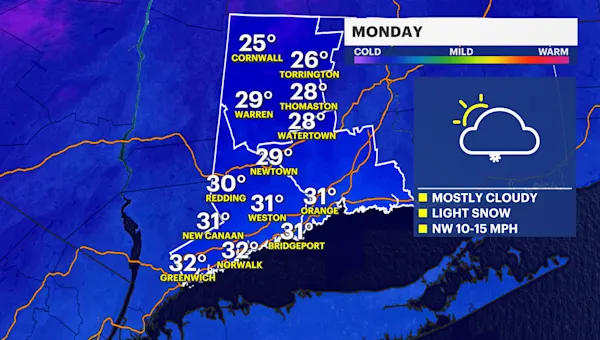
WHAT YOU NEED TO KNOW:
– The News 12 Storm Watch Team is tracking a snowstorm that continues to be mainly to the south of Connecticut.
– There is a chance for Fairfield and southernmost New Haven to see some light flurries.
– This is a quick moving system because south of Connecticut will get the northernmost part.
– Timing is mid-morning and clears by late afternoon. Amounts will likely be under a quarter of an inch.
– Windy weather will be behind the snow, which will bring gusts in the 20 to 30 mph range or even higher from Tuesday to Thursday. It will make already cold temperatures feel frigid.
– Precipitation wise, Monday’s snow is the main event for the work week which will not be a lot. Expect combinations of sun and clouds and wind for the rest of the work week. It’s far out, but there are some snow chances for next weekend that the News 12 Storm Watch Team will continue to monitor.
– Temperatures will feel extremely cold throughout the rest of the week, mainly highs in the 30s and 20s and lows in the teens and 20s. Wind chill will be a big factor over the next week.
FORECAST
OVERNIGHT: Mostly cloudy. Feeling very cold. Low of 22.
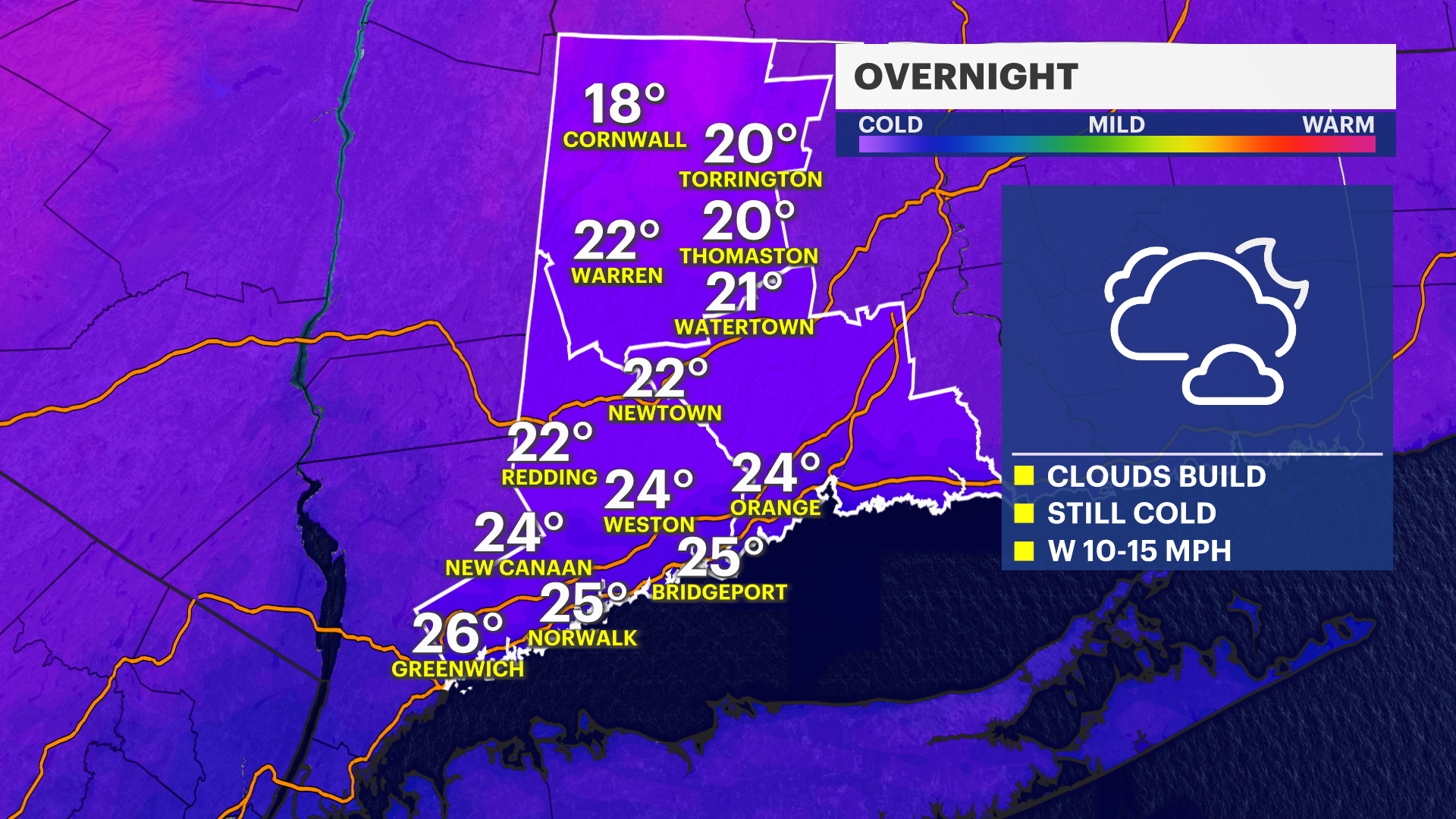
MONDAY: Mostly cloudy with a few flurries for some. High of 32, low of 18.
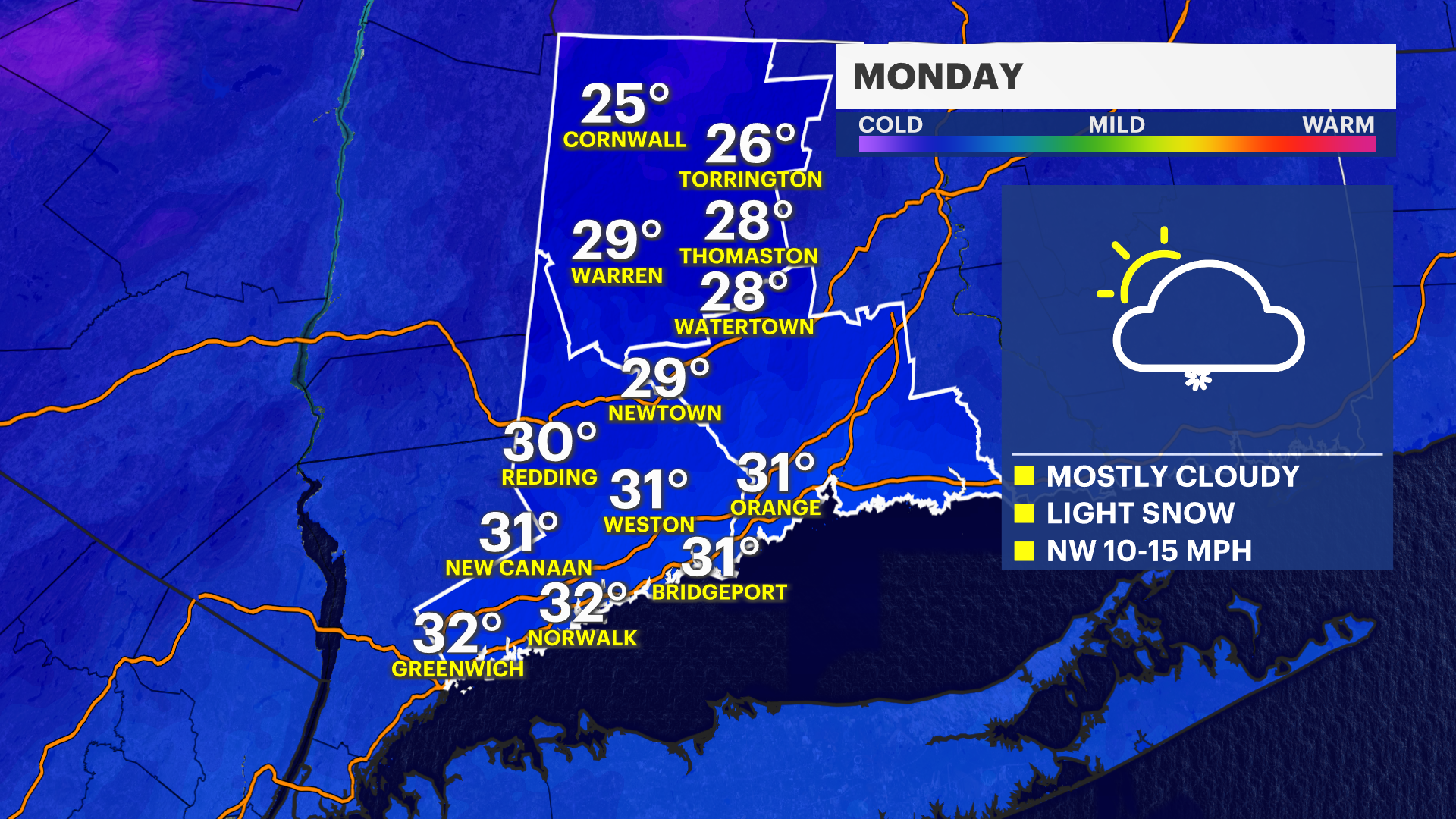
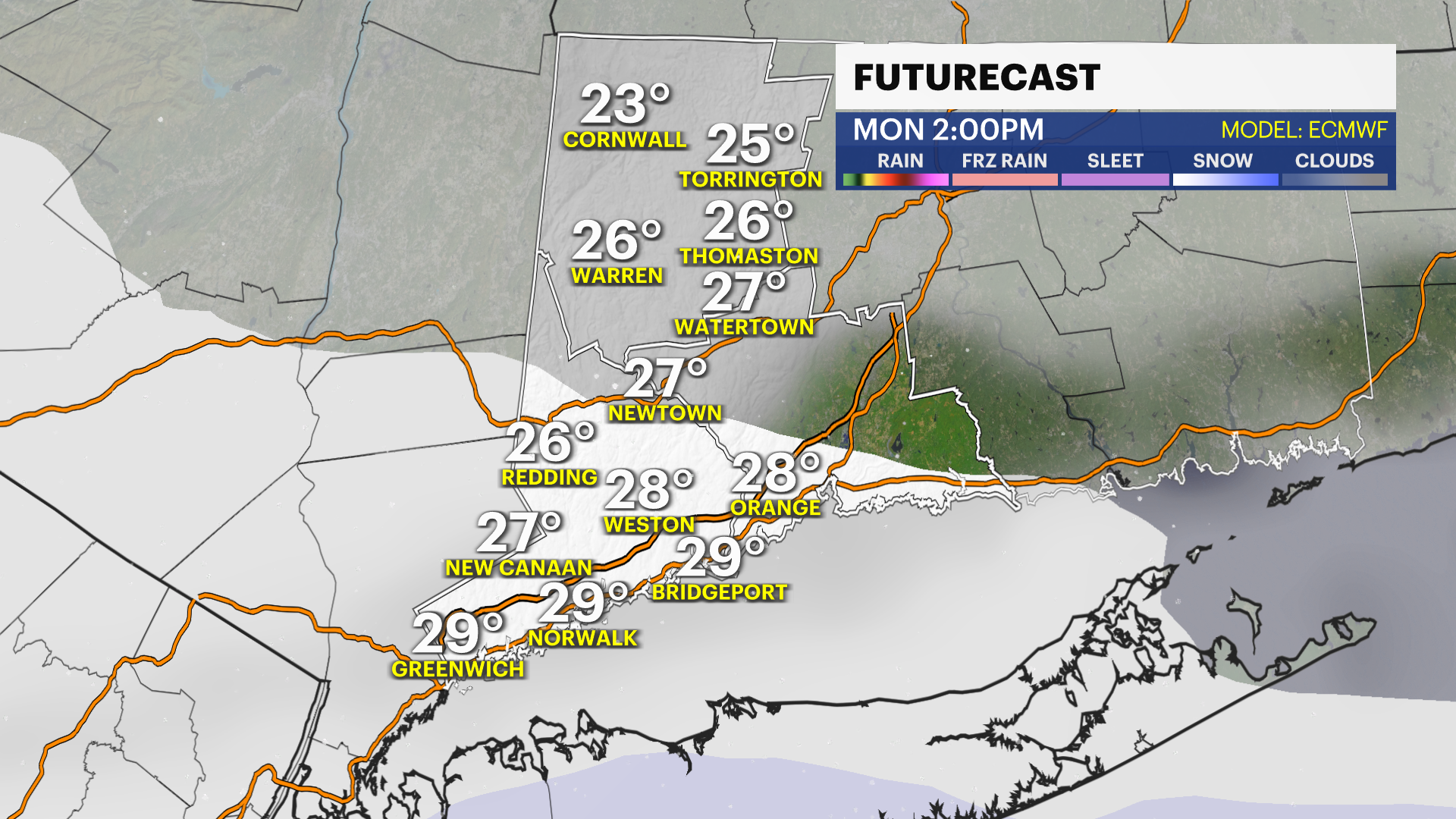
TUESDAY: Sun, clouds and windy. High of 31, low of 19.

WEDNESDAY TO FRIDAY: Breezy and gusty conditions remain. Highs in the 30s with Friday and the weekend getting into the upper-30s.
Connecticut
Reported shooting on I-91 in Hartford leaves 1 injured
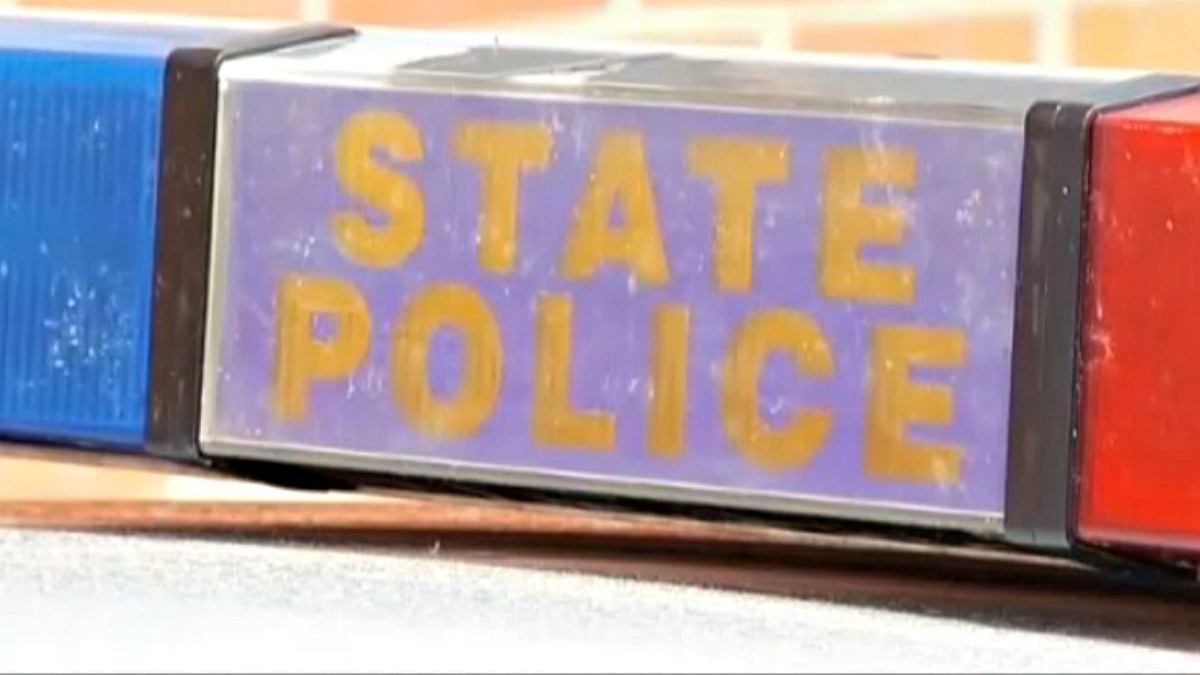
A reported shooting on Interstate 91 in Hartford left one person injured over the weekend.
Troopers responded to I-91 near the exit 27 on ramp for a reported shooting on Saturday around 10 p.m.
According to state police, one person was taken to the hospital. The extent of their injuries are unknown at this time.
Authorities did not release any additional details about the shooting.
The investigation is active and ongoing.
-

 Health1 week ago
Health1 week agoNew Year life lessons from country star: 'Never forget where you came from'
-
/cdn.vox-cdn.com/uploads/chorus_asset/file/24982514/Quest_3_dock.jpg)
/cdn.vox-cdn.com/uploads/chorus_asset/file/24982514/Quest_3_dock.jpg) Technology1 week ago
Technology1 week agoMeta’s ‘software update issue’ has been breaking Quest headsets for weeks
-

 Business5 days ago
Business5 days agoThese are the top 7 issues facing the struggling restaurant industry in 2025
-

 Culture5 days ago
Culture5 days agoThe 25 worst losses in college football history, including Baylor’s 2024 entry at Colorado
-

 Sports5 days ago
Sports5 days agoThe top out-of-contract players available as free transfers: Kimmich, De Bruyne, Van Dijk…
-

 Politics4 days ago
Politics4 days agoNew Orleans attacker had 'remote detonator' for explosives in French Quarter, Biden says
-

 Politics3 days ago
Politics3 days agoCarter's judicial picks reshaped the federal bench across the country
-

 Politics2 days ago
Politics2 days agoWho Are the Recipients of the Presidential Medal of Freedom?


















